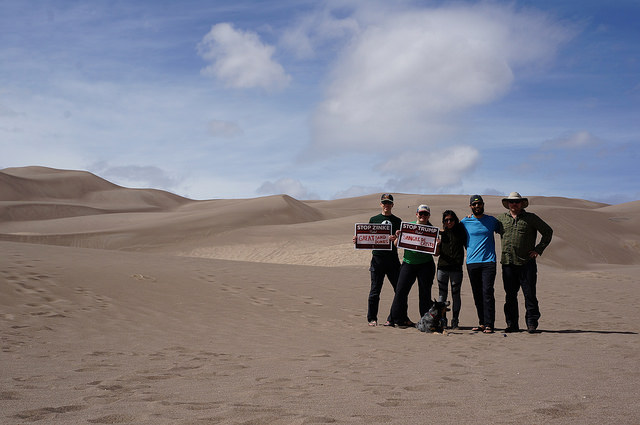In enjoying Colorado Public Lands, we may soak in the gratitude for the happy memories these lands have provided us, or perhaps reminisce upon the beauty we have been enveloped in as a result of the preservation of these sites. As we do so, we must also think to protect these lands so we may continue to enjoy them in this way. This year, the Trump Administration has placed the future of parks across the nation in jeopardy, and now our own Great Sand Dunes National Park and Preserve along with the Sangre de Cristo Wilderness is being threatened by oil and gas drilling just outside its borders.
Take action: Demand Senator Cory Gardner #DefendtheDunes by clicking here!

In 1932, President Herbert Hoover established the area on the western side of the Sangre de Cristo Mountains in Southern Colorado as Great Sand Dunes National Monument, and in 2000, thanks to massive public support across Colorado, President Bill Clinton updated this land to National Park status, making “Great Sand Dunes National Park and Preserve”. However, there is evidence of human interaction with the park as early as 11,000 years ago. These Dunes and the surrounding peaks have cultural significance to multiple Native American Nations, including the Ute, Navajo and Pueblos. For the Navajo Nation, Blanca Peak, a peak southeast of the dunes, is considered one of the most sacred mountains and called “Sisnaajini.” Some members of the Ute Nation think of the traditional word to describe the Great Sand Dunes, Saa waap maa nache, meaning “sand that moves.” The Tewa/Tiwa-speaking pueblos along the Rio Grande have a traditional site west of the Dunes called Sip’ophe, “Sandy Place Lake,” through which their people entered into the present world. This is to name only a few of the cultural connections to this area, all of which add to the importance of preserving this land.
Now, 86 years after the parks founding, and thousands of years since humans first connected with the Dunes, this space is under threat.
18,000 acres of Colorado’s public lands are to be auctioned in September for drilling, mining and fracking, as proposed by Interior Secretary Ryan Zinke. This proposed land is surrounding the National Park and the nearby Sangre de Cristo Mountains.
The park has helped to preserve the cultural sites in and surrounding the Dunes, which ultimately helped Native communities continue to preserve the history and traditions surrounding this land. The introduction of drilling to this area will threaten these communities’ ability to continue to do so, putting these traditions at stake while also disrespecting the cultural importance of theses spaces to Native American Nations.
Along with cultural harm, this drilling would have profoundly negative effects on the wildlife that exists in and around the park. Wildlife habitats certainly do not abide by the park boundaries, thus the drilling will disrupt the life of many species that exist in the area. Elk and Bighorn Sheep, to name only a few, both are in danger of losing a portion of their habitat in these parcels of land. The drilling would fragment these and other habitats, and thus harm the biodiversity of this area.
Air Quality faces degradation as well, particularly because the winds generally move east to west, pushing the pollution from the drilling site directly into the park, where many of us have experienced hiking swimming and playing in the iconic dunes.
Furthermore, The Wilderness Society released a report stating, “Greenhouse gas emissions associated with oil, gas, and coal from public lands are equivalent to one-fifth or more of total U.S. emissions.” This is unacceptable, and must not be allowed to continue, particularly not in any of our National Parks.
The Great Sand Dunes are praised for their incredible night sky that can be seen for miles while in or near the park. This drilling will cause a dark cloud to cover the stars from park-goers’ searching eyes. The stars will be limited even further by the light pollution that will enter the park’s areas from the drilling sites.
Beyond air pollution, the drilling sites come with guaranteed sound pollution. The National Park Service monitors the level of sound in different National Parks, and “Great Sand Dunes is one of the quietest locations ever monitored by the natural sounds program.” Not only is this important to wildlife in the area, but it also is a reason many visit the park. With this incredible silence, comes extreme susceptibility to harmful sound pollution. The Dunes are at great risk of losing this unique silence if the drilling does occur.
The question then becomes - what can we do? The decision is to be made officially in September, thus there is still time to preserve the culture and beauty in this pristine wilderness. With intense public pressure Interior Secretary Ryan Zinke has retracted proposals on other public lands including Chaco Canyon National Park and Yellowstone National Park, thanks to the help of the public and environmental groups.
In light of the danger Great Sand Dunes National Park faces, contributing to the public pressure that can shut down Zinke’s plans is perhaps the best way to celebrate Colorado’s Public Lands Day. Make your voice heard here by telling Senator Gardner to protect the Dunes and fight this drilling, and enjoy our great outdoors!
